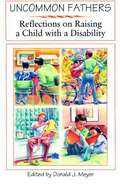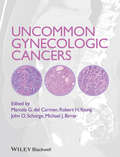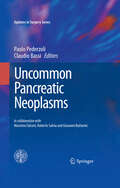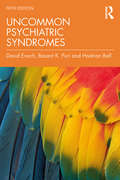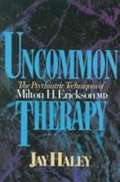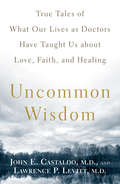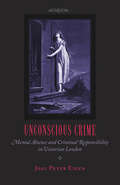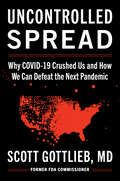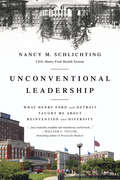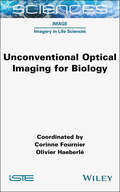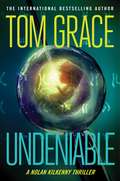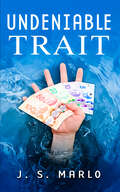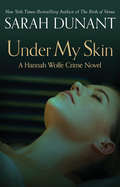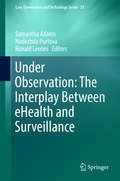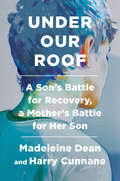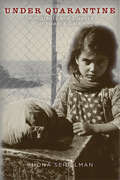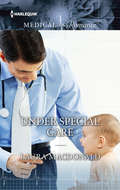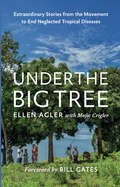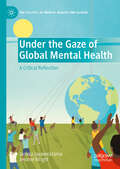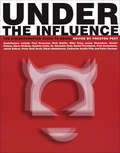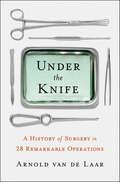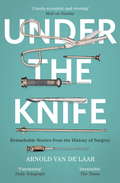- Table View
- List View
Uncommon Fathers: Reflections on Raising a Child with a Disability
by Donald J. MeyerUncommon Fathers is a compelling collection of essays by fathers who were asked to reflect and write about the life-altering experience of having a child with a disability. Nineteen fathers have taken an introspective and honest look at this deeply emotional subject, offering a seldom-heard perspective on raising children with special needs. (from the publisher)
Uncommon Gynecologic Cancers
by John O. Schorge Marcela Del Carmen Robert H. YoungRare gynecological cancers kill all too commonlyGynecological cancer is a frightening prospect for women. It is terrifying also for physicians who need, but often can't find, guidance on how to investigate and appropriately treat the tumors. Rare cancers provide greater challenges as information can be harder to find and more difficult to verify.Rare Gynecologic Cancers: Diagnosis and Management brings together all you need to know on these life-threatening diseases. Straightforward summaries of pathophysiologic processes lead to the investigations that will improve your diagnostic accuracy. This provides the basis for you to identify effective treatment strategies for your patients. Written by a world-leading team of Editors and Authors and covering cancers of the* Ovaries* Uterus* Vulva* Vagina* CervixRare Gynecologic Cancers: Diagnosis and Management will guide you to the best life-saving treatment for your patients.
Uncommon Pancreatic Neoplasms
by Claudio Bassi Paolo PederzoliUncommon tumors of the pancreas are of increasing interest for clinicians: cross imaging techniques development makes it possible to detect small lesions in the pancreatic gland of asymptomatic patients, and in the last decades a more detailed and specific pathological classification definitivelyopened an unexpected world of more or less rare pancreatic tumors. As a matter of fact, nowadays most surgical procedures deal with these so called uncommon pancreatic tumors such as cystic, endocrine and others unfrequent histotypes, and many patientsexperiencing an accidental discovery of this type of tumor need therefore a specialistic evaluation. The concept behind this volume is the need to give the correct clinical relevance to these "uncommon" tumors, that are ranked at the first place among pancreatic tumors, and that are definitively curable with a multimodal approach. Aim of the book is therefore to get clinicians closer to these pathologies, describing their complexity and the current state of the art in diagnostic, therapeutic and pathological classification strategy, thus providing them with the tools for a modern and updated clinical management of these patients.
Uncommon Psychiatric Syndromes (A\hodder Arnold Publication)
by Basant K. Puri David Enoch Hadrian BallThis book explores the historical background to, and present-day understanding of, a number of unusual psychiatric disorders. This fully revised new edition contains a new chapter on a range of recently emerging conditions as well as updated literature and a collection of new and updated cases. Since the publication of the fourth edition, there have been many developments in the field of psychiatry, including changes in the Diagnostic and Statistical Manual of Mental Disorders (DSM-5) and the advancement of neuroimaging and related research, which have been incorporated into the fifth edition. In this now classic text, each chapter covers an individual disorder in detail, using several case studies gathered by the authors themselves to illustrate and exemplify the disorders discussed. The clear and easy-to-understand writing style ensures that this text is accessible for the wide range of studies and professions who will find it useful. Uncommon Psychiatric Syndromes, Fifth Edition, is essential reading for psychiatrists, clinical psychologists, psychiatric nurses, psychiatric social workers, social workers and other mental health professionals. It will also be of interest to graduate students in the fields of psychiatry and psychology as well as those enrolled in psychiatry resident courses.
Uncommon Therapy: The Psychiatric Techniques of Milton H. Erickson Md
by Jay HaleyMilton H. Erickson, M. D. is generally acknowledged to have been the world's leading practitioner of medical hypnosis. His "strategic therapy," using hypnotic techniques with or without actually inducing trance, allows him to get directly to the core of a problem and prescribe a course of action that can lead to rapid recovery. This book provides a comprehensive look at Dr. Erickson's theories in practice, through a series of case studies covering the kinds of problems that are likely to occur at various stages of the human life cycle. The results Dr. Erickson achieves sometimes seem to border on the miraculous, but they are brought about by a finely honed technique used by a wise, intuitive, highly trained psychiatrist-hypnotist whose work is recognized as a major contribution to the field.
Uncommon Ulcers of the Extremities
by Ajay K. Khanna Satyendra Kumar TiwaryThe book covers all uncommon ulcers of the extremities which remain a difficult diagnosis for clinicians most of the times. A variety of causes like metabolic, infective, rheumatoid, drug induced or inflammation may lead to ulcerations. Diagnosis of these ulceration is difficult as these diseases are systemic, and treatment is carried out by physicians but ulcers are managed by the surgeons. Any lacunae or gap in assessment or work-up may lead to failure in diagnosis and increased morbidity. This book provides a systematic and step wise approach to the differential diagnosis of every possible uncommon ulcers in the extremities with detailed work-up, flow chart and summary. The book is systematically designed to serve the purpose of covering every possible uncommon ulcer with elaborate clinical presentation in the background of etiology and pathogenesis with risk factors included investigations and treatment with medical, surgical options well discussed as per the requirement. The book includes illustrations, flow diagrams, images, charts and tables. The book provides every information clinically relevant and useful about the uncommon ulcers and serves as a complete resource for general surgeons, vascular surgeons, plastic surgeons, orthopedic surgeons, surgical trainees, family physicians. It may also be useful for podiatrists, phlebologists, radiologists, cardiologists, nephrologists, neurologists, wound care nurses, physicians and primary care workers.
Uncommon Wisdom: True Tales of What Our Lives as Doctors Have Taught Us About Love, Faith and Hea ling
by John Castaldo Lawrence LevittIn light of the escalating costs of healthcare in the U.S. and the on-going debate about appropriate health insurance reform, it's easy to forget about the human side of medicine and the importance of the doctor-patient relationship. In Uncommon Wisdom, neurologists John Castaldo and Lawrence Levitt share what they have learned in their many years as doctors, not just from tests and labs, but from years of listening and learning from their patients. These 16 tales show doctors as human beings: flawed and full of doubt, wonder, and reverence about what it means to be alive. The stories remind us that the medical profession should be about treating people with the dignity they deserve and that medical miracles don't always involve medicine. These doctors find cures, solve mysteries, and glean many lessons from listening deeply to their patients.
Unconscious Crime: Mental Absence and Criminal Responsibility in Victorian London
by Joel Peter EigenA sleepwalking, homicidal nursemaid; a "morally vacant" juvenile poisoner; a man driven to arson by a "lesion of the will"; an articulate and poised man on trial for assault who, while conducting his own defense, undergoes a profound personality change and becomes a wild and delusional "alter." These people are not characters from a mystery novelist's vivid imagination, but rather defendants who were tried at the Old Bailey, London's central criminal court, in the mid-nineteenth century. In Unconscious Crime, Joel Peter Eigen explores these and other cases in which defendants did not conform to any of the Victorian legal system's existing definitions of insanity yet displayed convincing evidence of mental aberration. Instead, they were—or claimed to be—"missing," "absent," or "unconscious": lucid, though unaware of their actions.Based on extensive research in the Old Bailey Sessions Papers (verbatim courtroom narratives taken down in shorthand during the trial and sold on the street the following day), Eigen's book reveals a growing estrangement between law and medicine over the legal concept of the Person as a rational and purposeful actor with a clear understanding of consequences. The McNaughtan Rules of l843 had formalized the Victorian insanity plea, guiding the courts in cases of alleged delusion and derangement. But as Eigen makes clear in the cases he discovered, even though defense attorneys attempted to broaden the definition of insanity to include mental absence, the courts and physicians who testified as experts were wary of these novel challenges to the idea of human agency and responsibility. Combining the colorful intrigue of courtroom drama and the keen insights of social history, Unconscious Crime depicts Victorian England's legal and medical cultures confronting a new understanding of human behavior, and provocatively suggests these trials represent the earliest incarnation of double consciousness and multiple personality disorder.
Uncontrolled Spread: Why COVID-19 Crushed Us and How We Can Defeat the Next Pandemic
by Scott GottliebNEW YORK TIMES BESTSELLER“Uncontrolled Spread is everything you’d hope: a smart and insightful account of what happened and, currently, the best guide to what needs to be done to avoid a future pandemic." —Wall Street Journal“Informative and well paced.”—The Guardian“An intense ride through the pandemic with chilling details of what really happened. It is also sprinkled with notes of true wisdom that may help all of us better prepare for the future.”—Sanjay Gupta, MD, chief medical correspondent, CNNPhysician and former FDA commissioner Scott Gottlieb asks: Has America’s COVID-19 catastrophe taught us anything?In Uncontrolled Spread, he shows how the coronavirus and its variants were able to trounce America’s pandemic preparations, and he outlines the steps that must be taken to protect against the next outbreak. As the pandemic unfolded, Gottlieb was in regular contact with all the key players in Congress, the Trump administration, and the drug and diagnostic industries. He provides an inside account of how level after level of American government crumbled as the COVID-19 crisis advanced.A system-wide failure across government institutions left the nation blind to the threat, and unable to mount an effective response. We’d prepared for the wrong virus. We failed to identify the contagion early enough and became overly reliant on costly and sometimes divisive tactics that couldn’t fully slow the spread. We never considered asymptomatic transmission and we assumed people would follow public health guidance. Key bureaucracies like the CDC were hidebound and outmatched. Weak political leadership aggravated these woes. We didn’t view a public health disaster as a threat to our national security.Many of the woes sprung from the CDC, which has very little real-time reporting capability to inform us of Covid’s twists and turns or assess our defenses. The agency lacked an operational capacity and mindset to mobilize the kind of national response that was needed. To guard against future pandemic risks, we must remake the CDC and properly equip it to better confront crises. We must also get our intelligence services more engaged in the global public health mission, to gather information and uncover emerging risks before they hit our shores so we can head them off. For this role, our clandestine agencies have tools and capabilities that the CDC lacks.Uncontrolled Spread argues we must fix our systems and prepare for a deadlier coronavirus variant, a flu pandemic, or whatever else nature -- or those wishing us harm -- may threaten us with. Gottlieb outlines policies and investments that are essential to prepare the United States and the world for future threats.
Unconventional Leadership: How Henry Ford Taught Me About Reinvention and Diversity
by Nancy M. SchlichtingWhat does it take to lead the successful turnaround of four consecutive organizations? What does it take to run a $4 billion business in Detroit as the city struggles to emerge from municipal bankruptcy and its worst ongoing crisis ever? What does it take to be a female CEO who has come up against discrimination and personal attack? It takes Unconventional Leadership, a style of leadership based on confronting reality and leading headlong through adversity. In this inspiring story, Nancy Schlichting, the CEO of Henry Ford Health System, reveals her unique strategies that drive success: maintaining a focus on people, creating a culture of innovation and reinvention, and embracing diversity as a key strategy for growth. The book describes a leadership paradigm that will motivate, inspire, and drive new thinking in today's disruptive business environment where traditional modes of managing are no longer working. In Unconventional Leadership, Schlichting weaves together three themes that explain how she has become one of the most powerful individuals in healthcare today: (1) deftly conquering the immense challenges within the healthcare industry itself--consolidation, new models of delivery and financing, increasing government regulation and oversight, changing customer expectations, and pressures on cost and quality (2) the exciting and panoramic backdrop of Henry Ford and Detroit--Ford's legacy of invention and innovation combined with ongoing attempts to restore and renew a city in deep decline; and (3) forging a career path and excelling as a female CEO in a world typically dominated by men. An abiding fan of the underdog, Schlichting reveals, above all else, the sheer grit and determination required to lead through adversity and create a successful legacy of leadership.
Unconventional Optical Imaging for Biology
by Corinne Fournier Olivier HaeberléOptical imaging of biological systems has undergone spectacular development in recent years, producing a quantity and a quality of information that, just twenty years ago, could only be dreamed of by physicists, biologists and physicians. Unconventional imaging systems provide access to physical quantities – phase, absorption, optical index, the polarization property of a wave or the chemical composition of an object – not accessible to conventional measurement systems. To achieve this, these systems use special optical setups and specific digital image processing to reconstruct physical quantities. This field is also known as computational imaging. This book presents various non-conventional imaging modalities developed for the biomedical field: wave front analysis imaging, digital holography/tomography, optical nanoscopy, endoscopy and singlesensor imaging. Experimental setups and reconstruction algorithms are presented for each modality.
Uncovering Critical Personalism: Readings from William Stern’s Contributions to Scientific Psychology (Palgrave Studies in the Theory and History of Psychology)
by James T. LamiellThis book brings together the central tenets of William Stern’s critical personalism. Presented for the first time for an English-speaking audience, this selection of original translations and essays encapsulates the critical framework of Stern’s personalistic psychology. The selected works highlight the philosophical basis of Stern’s personalistic views, illustrate their relevance in domains of theoretical and practical importance in psychology, and reveal Stern’s critical stance on certain methodological trends that were gaining favor within psychology during his lifetime. Lamiell’s own chapters contextualise the translations by providing an overview of the most basic tenets of critical personalism, and offering a commentary on paradigmatic commitments within scientific psychology’s mainstream that began to impede Stern’s efforts prior to his death, and that remain obstacles to personalistic thinking in the discipline today. Largely ignored by his contemporaries, this work forms part of an emerging body of scholarship that seeks to reintroduce Stern’s thinking into contemporary psychology. The book is intended for academically oriented scholars with interests in historical, theoretical and philosophical issues in psychology.
Und jetzt Sie! – Selbst- und Zeitmanagement in Gesundheitsberufen: Selbst- Und Zeitmanagement In Gesundheitsberufen (Top im Gesundheitsjob)
by German Quernheim Claudia StyrskySie können mehr als Sie denken! „Arbeitsverdichtung" findet überall statt. Da bilden auch und vor allem die Gesundheitsfachberufe keine Ausnahme. Aber die Beschäftigten haben es stets mit kranken Menschen und deren Bedürfnisse zu tun. Wie also schafft man den Spagat zwischen den eigenen und den Bedürfnissen der anderen? Doch statt vor den eigenen und den fremden Ansprüchen zu kapitulieren, kann man sein "Schicksal" selbst in die Hand nehmen und die eigenen Ressourcen für sich nutzen. Selbstmanagement heißt die Devise! Anhand von Beispielen aus dem Alltag gibt der Autor German Quernheim zahlreiche Tipps und Tricks: knapp, humorvoll und umsetzbar. Mit zahlreichen Selbsttests, Übungen und Trainingsprogrammen.
Undeniable (Nolan Kilkenny #6)
by Tom GraceEx-Navy SEAL Nolan Kilkenny receives a desperate plea for help from doctors frantic to save the life of a young boy with a deadly genetic disorder. The boy, who came to his parents through a blind adoption, has no known blood relatives. Nolan agrees to help, but as he is being prepped for surgery, the boy dies. Further genetic testing then reveals an astonishing truth: Nolan and the boy share the same biological father. Nolan must confront his own father to find out the truth behind the discovery, and uncovers a heinous blackmail plot and desperate victims and villains. <p><p> Undeniable, the sixth Nolan Kilkenny thriller from international bestselling author Tom Grace, takes Nolan into the brave new world of reproductive technology, where the building blocks of life are manipulated in a Petri dish, women lease their wombs like rental properties, and money trumps morality. In an age of rapid advances in human genetics, cloning and stem cell research, what seemed impossible just a few years ago is now a reality. DNA has been reduced from a miraculous molecule into a data storage device, and the information it contains is as easy to hack as any computer file. Undeniable is a novel that steps beyond the traditional parent-child relationship into a chilling new reproductive reality. Undeniable, the sixth Nolan Kilkenny thriller from international bestselling author Tom Grace, takes Nolan into the brave new world of reproductive technology, where the building blocks of life are manipulated in a Petri dish, women lease their wombs like rental properties, and money trumps morality. In an age of rapid advances in human genetics, cloning and stem cell research, what seemed impossible just a few years ago is now a reality. DNA has been reduced from a miraculous molecule into a data storage device, and the information it contains is as easy to hack as any computer file. Undeniable is a novel that steps beyond the traditional parent-child relationship into a chilling new reproductive reality.
Undeniable Trait
by J.S. MarloHoping to start afresh, Dr. Zachary Auckerman moves to a northern Canadian town in desperate need of a doctor. Within days of his arrival, he stumbles onto suspicious deaths and illegal activities at the nursing home, and encounters a fascinating female plumber with a spunky personality and six fingers on her left hand. The murder of her mother, a woman who seduced and extorted men, prompts Willow to dig into her past and seek her father's identity, but the secrets surrounding her birth are buried deep in old medical files and locked in the ravaged mind of her grandmother who lives at the nursing home. Amid rumors, lies, deceit, and betrayal, Willow and Zachary hunt for the truth, unleashing deadly events that threaten their lives. Can they trust their hearts, and each other, before one of them becomes the next victim?
Under My Skin: A Hannah Wolfe Mystery (The Hannah Wolfe Crime Novels #3)
by Sarah DunantA private eye infiltrates a health spa in this witty crime novel from the CWA Silver Dagger Award–winning author of The Birth of Venus Dead carp floating in the Jacuzzi isn&’t the latest youth and beauty elixir for the elite patrons of Castle Dean spa, and owner Olivia Marchant is desperate to find the culprit before she loses all her clients. London PI Hannah Wolfe is plucked, crimped, steamed, and oiled while trying to uncover a spiteful saboteur who isn&’t above putting maggots in the yogurt and nails in the massage heads. Olivia also wants the sleuth to look into a series of threatening notes someone has been sending her husband, Maurice. Celebrity plastic surgeon Maurice Marchant has left some very disgruntled former patients in his wake. Women who have gone under his knife are now coping with less-than-perfect liposuction, drooping faces, and breast enlargements that went south. And when the case morphs into murder, Hannah confronts an embarrassment of suspects with means, motive, and opportunity. Tracking a killer while running surveillance on her sister&’s potentially philandering husband takes Hannah out of her comfort zone and into a rarefied world where appearances aren&’t just deceiving—they&’re deadly. The quest for beauty is taken to diabolical lengths in this smart thriller from New York Times–bestselling author Sarah Dunant—a must-read for fans of Kinsey Millhone and Philip Marlowe. Under My Skin is the 3rd book in the Hannah Wolfe Crime Novels, but you may enjoy reading the series in any order.
Under Observation: The Interplay Between eHealth and Surveillance
by Ronald Leenes Samantha Adams Nadezhda PurtovaThe essays in this book clarify the technical, legal, ethical, and social aspects of the interaction between eHealth technologies and surveillance practices. The book starts out by presenting a theoretical framework on eHealth and surveillance, followed by an introduction to the various ideas on eHealth and surveillance explored in the subsequent chapters. Issues addressed in the chapters include privacy and data protection, social acceptance of eHealth, cost-effective and innovative healthcare, as well as the privacy aspects of employee wellness programs using eHealth, the use of mobile health app data by insurance companies, advertising industry and law enforcement, and the ethics of Big Data use in healthcare. A closing chapter draws on the previous content to explore the notion that people are 'under observation', bringing together two hitherto unrelated streams of scholarship interested in observation: eHealth and surveillance studies. In short, the book represents a first essential step towards cross-fertilization and offers new insights into the legal, ethical and social significance of being 'under observation'.
Under Our Roof: A Son's Battle for Recovery, a Mother's Battle for Her Son
by Madeleine Dean Harry CunnaneA congresswoman and her son reveal how he survived a ten-year battle with opioid abuse—and what their family&’s journey to recovery can teach us about finding hope amid the unspeakable.When Madeleine Dean discovered that her son Harry was stealing from the family to feed a painkiller addiction, she was days away from taking the biggest risk of her life: running for statewide office in Pennsylvania. For years, she had sensed something was wrong. Harry was losing weight and losing friends. He had lost the brightness in his eyes and voice, changing from a young boy with boundless enthusiasm to a shadow of himself, chasing something she could not see. Now her worst fears had come to light. Under Our Roof is the story of a national crisis suffered in the intimacy of so many homes, told with incredible candor through the dual perspectives of a mother rising in politics and a son living a double life, afraid of what might happen if his secret is exposed. In this honest, bracing, yet ultimately uplifting memoir, they discuss the patterns of a family dealing with an unspoken disease, the fear that keeps addicts hiding in shame, and the moments of honesty, faith, and personal insight that led to Harry&’s recovery. In a country searching for answers to the devastating effects of opioids and drug abuse, Under Our Roof is a ray of hope in the darkness. It is not only a love story between mother and son but also an honest account of a pressing national crisis by a family poised to make a difference.
Under Quarantine: Immigrants and Disease at Israel’s Gate
by Rhona SeidelmanUnder Quarantine is the riveting story of Shaar Ha’aliya, a central immigrant processing camp opened shortly after Israel became an independent state. This historic gateway for Jewish migration was surrounded by a controversial barbed wire fence. The camp administrators defended this imposing barrier as a necessary quarantine measure - even as detained immigrants regularly defied it by crawling out of the camp and returning at will. Focusing on the conflicts and complications surrounding the medical quarantine, this book brings the history of this place and the remarkable experiences of the immigrants who went through it to life. Evocative and bold, Under Quarantine shows that we cannot fully understand Israel until we understand Shaar Ha’aliya. The gate of arrival for nearly half a million immigrants - a space of homecoming, conflict, exclusion and welcoming - here was the country’s crucible.
Under Special Care
by Laura MacdonaldA year ago mutual attraction flared between Sister Louise Keating and Dr. Matt Forrester, and a whirlwind marriage soon followed. But finding time for each other in their busy work schedules proved impossible, and they separated. Now they're working together again in the special-care baby unit. As the lives of their tiny patients hang constantly in the balance, Louise and Matt ride a roller coaster of emotions that takes them to a new level of intimacy. The question is, as they heal these fragile babies, can they also heal their marriage — with a little special care?
Under the Big Tree: Extraordinary Stories from the Movement to End Neglected Tropical Diseases
by Mojie Crigler Ellen AglerPowerful stories of the debilitating effects of neglected tropical diseases throughout the world, highlighting the successes and challenges of those fighting to eliminate them.Neglected tropical diseases (NTDs) affect over one billion of the world's poorest people. More than 170,000 people die from NTDs each year, and many more suffer from blindness, disability, disfigurement, cognitive impairment, and stunted growth. Yet NTDs are treatable and preventable, and the annual cost of treatment is incredibly low.In Under the Big Tree, public health leader Ellen Agler and award-winning writer Mojie Crigler tell the moving stories of those struggling with these diseases and the life-saving work that can be—and has been—done to combat NTDs. They introduce readers to people from all walks of life—from car washers in Lake Victoria and surgeons on motorbikes to under-resourced local nongovernmental organizations (NGOs) and Big Pharma scientists—as they chronicle what has been called the largest public health program in the world. On the one hand, the solutions are simple: deliver medication to people who need it and leverage local systems to offer prevention, treatment, and education. On the other hand, solutions are complex: navigating local and national politics, delivering treatment to some of the most remote, vulnerable communities, and coordinating global and local donors, international NGOs, thousands of health workers, and millions of citizens. Drawing on interviews with major players in the NTD world who share their cutting-edge research and frontline experiences, Under the Big Tree is a moving introduction to the science, the tactics, and the partnerships working to address these terrible diseases that affect the most vulnerable people in the world. With a foreword by Bill Gates, this book fascinates, inspires, and gives readers concrete steps for further engagement.
Under the Gaze of Global Mental Health: A Critical Reflection (The Politics of Mental Health and Illness)
by Janaka Jayawickrama Jerome WrightThis book critically examines how the globalisation of mental health through the dominant medical model has created barriers to understanding and responding to distress with reference to cases from Malawi and Sri Lanka. Its authors argue that mental health must be understood within the overall health of an individual, and individual health is located within the social, political, cultural, economic, and environmental context in which they live. Their analyses demonstrate that supplanting locally developed responses to distress with a Western medicalised model of mental health inhibits a meaningful engagement with individuals and communities in need of care. Further, they argue that this &‘supplanting&’ is analogous with a colonial endeavour, and one which diverts attention from the real problems of development. Across contexts the book highlights the difficulties that mental health professionals face in facilitating individuals&’ capacities within structurally damaging socio-economic environments and increasingly commercially orientated health systems. This book will appeal in particular to students, researchers and practitioners working across the fields of mental health, medical anthropology, social work, and health and development studies.
Under the Influence: The Disinformation Guide to Drugs (Disinformation Books)
by Preston PeetThis myth-busting anthology cuts through the propaganda to tell the true story of drug use, abuse, and the costly war on friends, families and communities. Author and regular High Times contributor Preston Peet assembles an all-star cast of writers to shine a harsh light on the misinformation peddled by prohibitionists who profit from the War on Some Drugs and Users. Despite the anti-drug hysteria, drugs have been an integral aspect of human life for thousands of years. They cure diseases, ease pain, enhance intelligence, calm nerves, open the doors of perception and alter consciousness. Yet, even with the easing of marijuana restrictions, the War on Some Drugs and Users continues to persecute huge swaths of the population. The reasons why can be found in Under the Influence. The decades and trillions of dollars spent waging war on neighbors, friends and families have done nothing to eradicate drug use and abuse, but they have succeeded in overthrowing governments, tearing apart families and communities, and ensured the rise of international criminal cartels. Under the Influence explains how we came to this state of affairs and how we can bring about real reform. Contributors include Tom Robbins, Paul Krassner, Rick Doblin, Mike Gray, Lonny Shavelson, Daniel Forbes, Steve Wishnia, Cynthia Cotts, Russ Kick, Dr. Stanislav Grof, Daniel Pinchbeck, Paul Armentano, Jacob Sullum, Peter Dale Scott and Robert Anton Wilson.
Under the Knife: A History of Surgery in 28 Remarkable Operations
by Arnold van de LaarSurgeon Arnold van de Laar uses his own experience and expertise to tell this engrossing history of surgery through 28 famous operations—from Louis XIV and Einstein to JFK and Houdini.From the story of the desperate man from seventeenth-century Amsterdam who grimly cut a stone out of his own bladder to Bob Marley's deadly toe, Under the Knife offers a wealth of fascinating and unforgettable insights into medicine and history via the operating room.What happens during an operation? How does the human body respond to being attacked by a knife, a bacterium, a cancer cell or a bullet? And, as medical advances continuously push the boundaries of what medicine can cure, what are the limits of surgery?With stories spanning the dark centuries of bloodletting and amputations without anaesthetic through today's sterile, high-tech operating rooms, Under the Knife is both a rich cultural history, and a modern anatomy class for us all.
Under the Knife: A History of Surgery in 28 Remarkable Operations
by Arnold van Laar'This is history with a surgeon's touch: deft, incisive and sometimes excruciatingly bloody' The Sunday Times'Utterly eccentric and riveting' Mail on Sunday 'Eye-opening and, frequently, eye-watering . . . a book that invites readers to peer up the bottoms of kings, into the souls of rock stars and down the ear canals of astronauts' The Daily TelegraphHow did a decision made in the operating theatre spark hundreds of conspiracy theories about JFK? How did a backstage joke prove fatal to world-famous escape artist Harry Houdini? How did Queen Victoria change the course of surgical history?Through dark centuries of bloodletting and of amputations without anaesthetic to today's sterile, high-tech operating theatres, surgeon Arnold van de Laar uses his experience and expertise to tell an incisive history of the past, present and future of surgery.From the dark centuries of bloodletting and of amputations without anaesthetic to today's sterile, high-tech operating theatres, Under the Knife is both a rich cultural history, and a modern anatomy class for us all.
